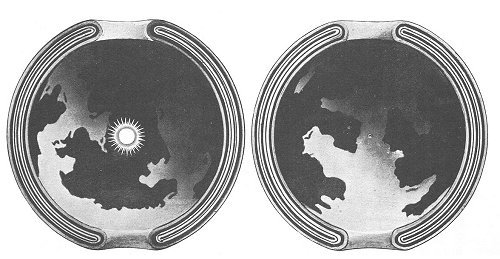
Sacred Texts Earth Mysteries

 |
A Journey to the Earth's Interiorby Marshall B. Gardner[1920] |
Marshall B. Gardner, a hollow-earth proponent, published the first edition of this book in 1913, after Peary reached the North Pole in 1909. Gardner thus had a much harder job than William Reed; that is, overcoming the public perception that the poles had been reached.
Gardner's book is in some ways superior to other books in this genre. He attempts to come up with a scientific hypothesis to explain the formation of hollow planets, instead of divine fiat or no explanation at all. He is also a lot more readable. One of the most enjoyable parts of this book is Gardner's fantasy account of a journey into the interior of the hollow earth, which, while not up to the standards of Jules Verne, seems almost plausible if you can suspend your disbelief temporarily.
Naturally, a great deal of the book consists of narratives of arctic explorers (covering some of same material as Reed). The book marshals a great deal of anomalous polar evidence, such as attested warm regions near the poles, red dust, strange auroras and so on. Last but not least are those poor flash-frozen Siberian mammoths, who seem to crop up with such regularity in the crank literature,--probably because traditional scientific explanations of their demise always sound so fishy when quoted out of context.
There is a long section at the end where he deals with the response to the first edition of his book, including an opponent who raises a theory of a prehistoric 90 degree polar shift to account for some of the same evidence! By contrast, a hollow earth would definitely be more plausible.
Although Gardner doesn't attack the scientific method or basic physical laws, as other alternative earth theorists do, perhaps he should have. According to traditional physics, inside of a hollow earth-sized sphere there should be zero gravity; and centrifugal force caused by the earth's rotation would be insufficient to keep things inside the hollow earth from floating away, either. Working out the math of a star small enough to fit inside the earth, not too hot to fry the interior surface, and not too dense to turn into a black hole is 'left as an exercise.' The charming idea of denizens of the hollow earth going about their business lit by a never-setting mini-sun is simply a fantasy.
--John Bruno Hare, 6/28/2005